Building a Flow
This article covers everything you'll need to know about building a Flow. If you get stuck at a point below, please reach out to help@parabola.io — we're here to support you, and together we can build great things.
In this section, we'll cover:
- Key terms to know for building
- Working with steps
- Main building blocks of a Flow
- Navigating around the canvas
- Adding cards
- Using keyboard shortcuts
- Editing and updating your Flow version(s)
Now let's get started!
Key building terms to know
Flow: These are automations built in Parabola; they look like a flowchart in your favorite dot-ruled notebook.
Steps: Flows are made up of steps and arrows. Every step either pulls in data into Parabola, pushes data out of Parabola, or transforms data within Parabola. Think of these as your data choreography or sheet music. In the screenshot below, you'll see two steps. One is an integration pulling in data from Google Drive and the other is a transform that cleans the data in a specific way.

Arrows: Arrows connect steps, telling Parabola how data should flow between them.
Canvas: Flows are built on that dot-ruled paper, called the canvas. It's where you add and arrange your steps and arrows.
Cards: Cards group steps together and add organization to your Flow. They also feature a rich-text editor to give detailed descriptors and provide additional context to your step groups.
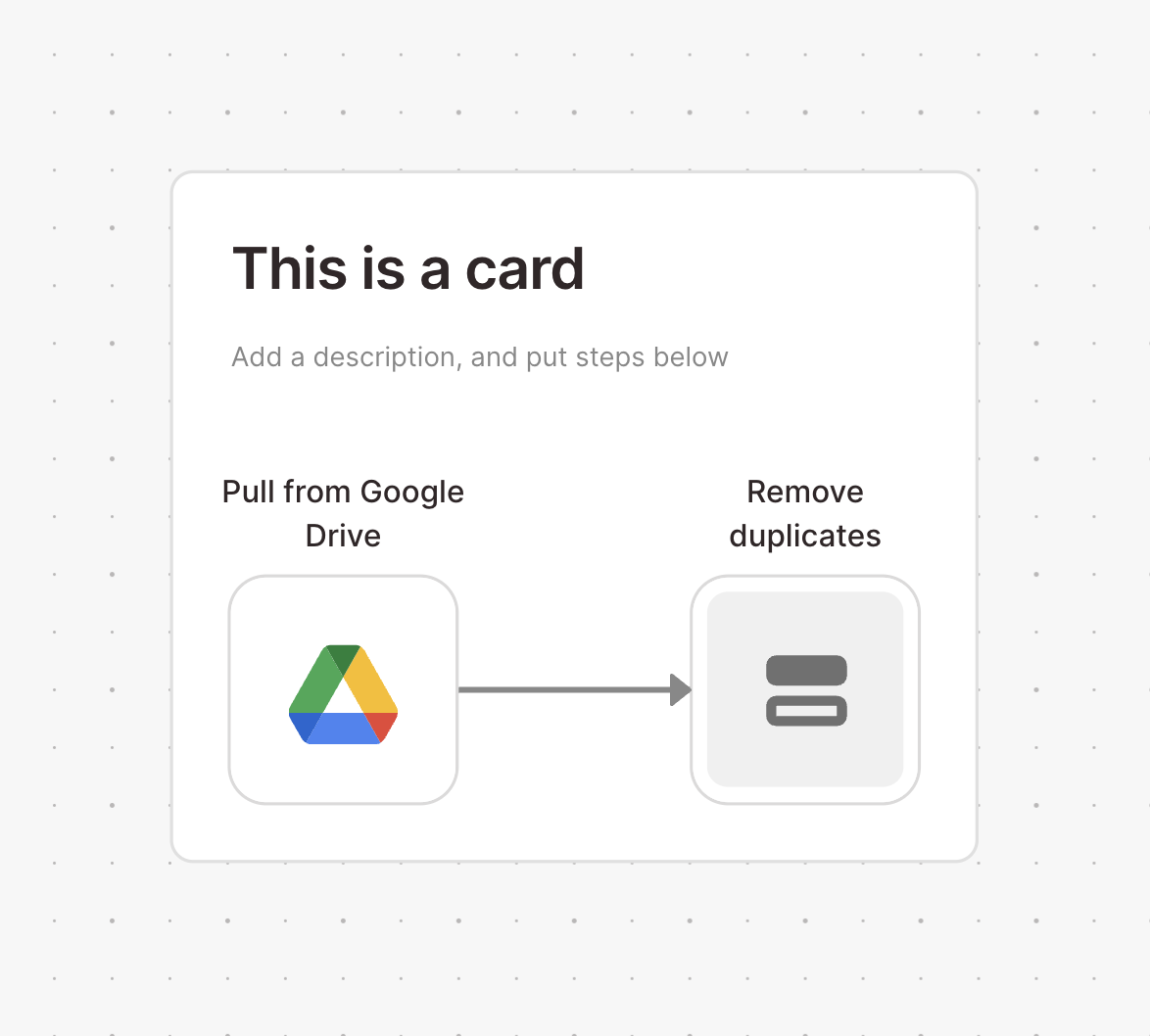
Working with steps
Parabola Flows are composed of steps. Every step does a specific task, like find and replace or filter your data. We can place steps anywhere on our canvas. Drag them around and connect them to each other to pass data.
Main building blocks of a Flow
When building a Flow, start with a source step to bring data into Parabola and then use transform steps to make changes to your data, such as removing columns. Flows end with exporting the data out of Parabola, like updating a Google Sheet or sending an email. Parabola does not store data (other than flat files like CSV or Excel files), so Parabola Flows always pull data directly from your source (ex: Shopify, Shipstation, Facebook Ads) and export to your destination for safekeeping (ex: Google Sheets, CSV files, Shopify).
Check out the Parabola University video below for an intro to pulling data from an external source.
Finding steps
Steps can be found using the canvas toolbar at the top of the page. You can search for steps by typing in keywords, or click “Integrations” or “Transforms” to see the complete list of steps in those sections.
To understand what a step does, hover over it and an explanatory tool tip will appear:
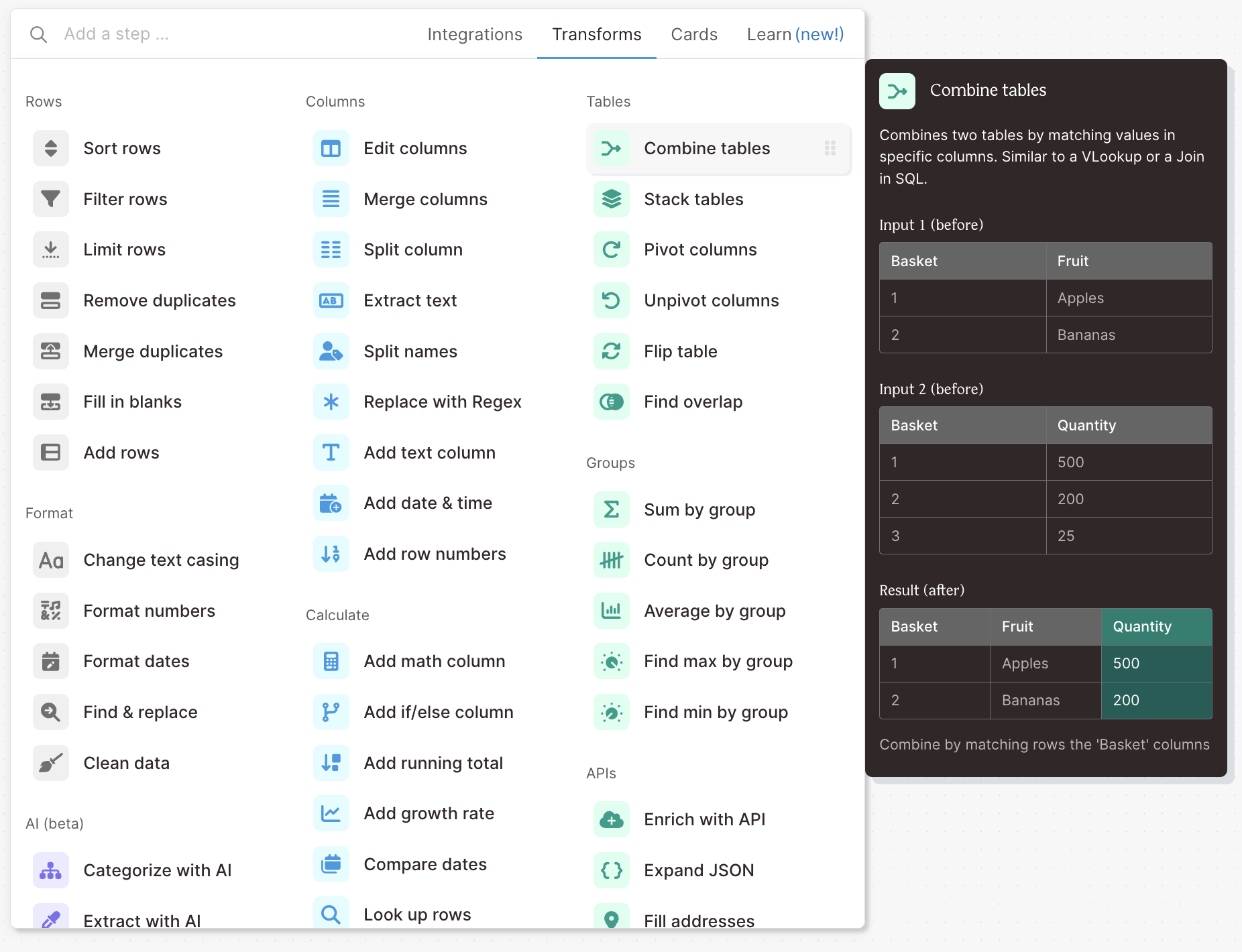
Once you find the step you're looking for, add it to the canvas by either clicking on the step or dragging it onto the canvas. You can place it anywhere you'd like.
- Steps that enable you to pull data into Parabola from your source can be found in the lefthand “Sources” section of the “Integrations” tab.
- Steps that enable you to send data out of Parabola can be found in the righthand "Destinations" section of the “Integrations” tab.
- Steps that enable you to transform data in Parabola can be found under the "Transforms" tab. The “Transforms” tab contains different sections for how those steps function.
Watch this Parabola University video to see transform steps in action.
Configuring and editing steps
Once you have a step on your canvas, you can configure it by either double-clicking on the step itself or by clicking on the pencil-and-paper icon that appears when you hover over the step.

The steps' settings always live on the lefthand side. Once you've made your selections, make sure to click "Show Updated Results" to see your data update. Data in Parabola is always presented in a familiar table format.
When you're configuring a step, you can also use the "Search" bar at the top of the resulting data. We'll focus you in on the columns and rows that contain what you're looking for, but you can always expand columns and rows if you need more context.

Lastly, you'll notice one or more tabs at the top of your settings window.
The 'Results' tab shows the data as it will be sent to the next step -- either as it's pulled into a "Sources" step, or after it's manipulated by a "Transforms" step.
Steps that are transforming data will also display one or more 'Input' tabs, titled according to the order in which they are connected, and the names of the connected steps.
Your steps that send data out of Parabola will show an 'Export' tab in the place of the results tab, showing data as it will be passed to its final destination. To the right of this tab will appear one or more additional 'Export' tabs in place of your 'Input' tabs. These tabs will show the data as it flows into the step.
Authorizing a step
For our integration steps where you connect to a third-party service outside of Parabola, the first step will always be to authorize the step. Clicking "Authorize" will pop open a small window for you to login to that external service. Please note that authorizations to third-party services are currently controlled at the flow-level. You will be asked to reauthorize to the same service when working on another flow.
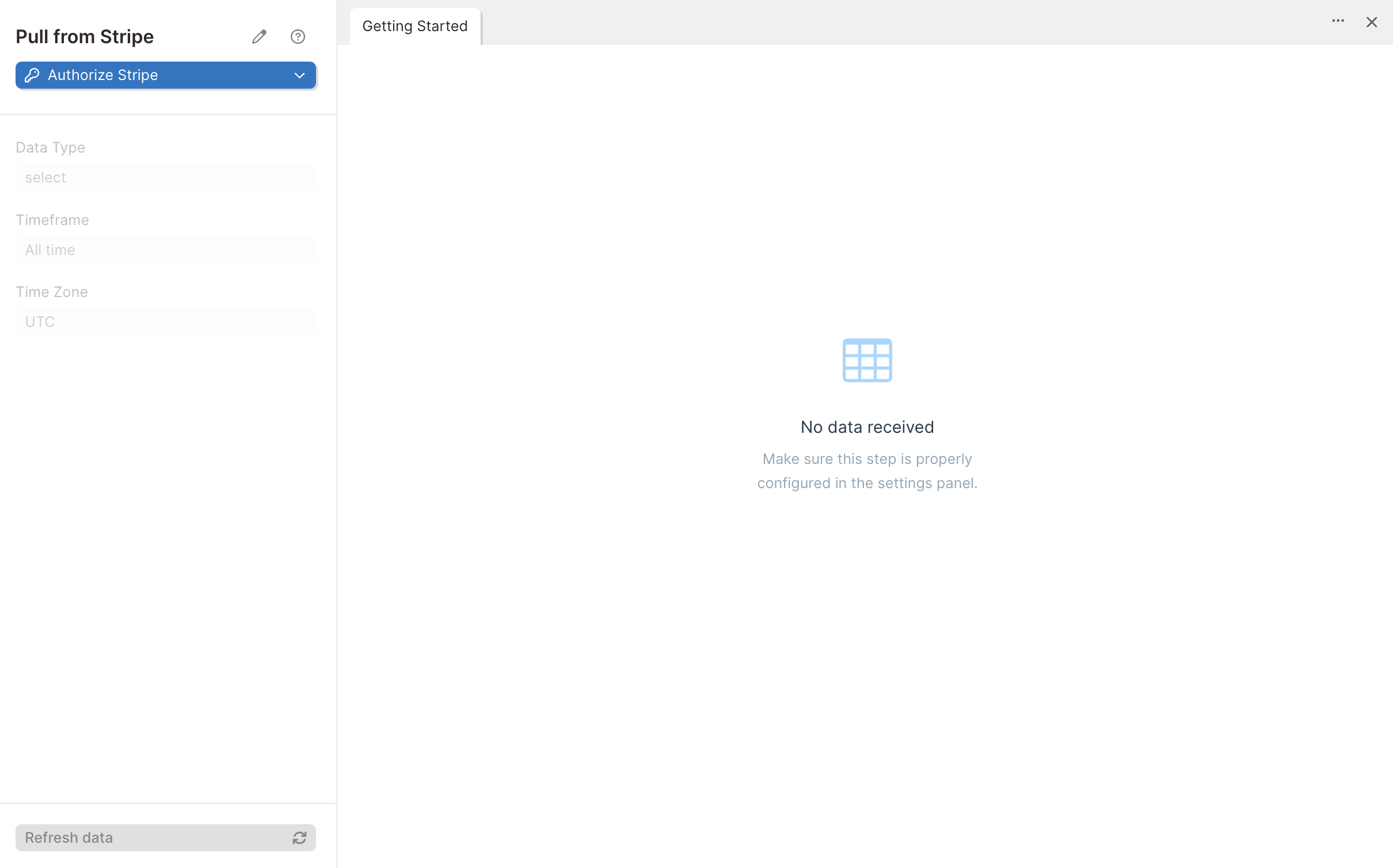
If you ever need to add, edit, or delete your authorization, click on the "Edit Accounts" dropdown in the top left corner of your step. You can select the option to "Add new account" or click "Edit" to edit or delete an existing account. Once you click "Edit", a pencil and trash icon will appear. Clicking the pencil icon will allow you to edit your authorization including renaming it, and clicking the trash icon will delete the authorization. If you delete an authorization in this way, all other steps in your flow connected to the same authorization will also lose its authentication.
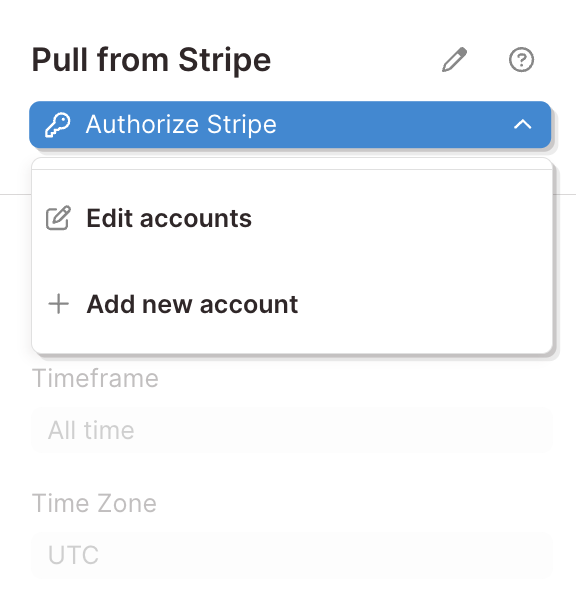
Moving steps
To move a single step on your flow, click and hold on the step and move your mouse. You'll see that the step moves where your mouse moves. You can release your step by lifting your finger off the mouse.
To move multiple steps on your flow, first, select the steps that you'd like to move. You can hold the shift key and click on every step you are interested in copying. Or, you can hold shift, click on an empty portion of your canvas, and then drag a box to select a large group of steps. If you select too many, hold shift and click a step to deselect it. If you copy steps connected together by arrows, their connections will be maintained when pasted.
Once the steps you'd like to move are selected, hold down on your mouse and move your mouse around. The same way you move a single step, you'll see that the group of steps moves where your mouse moves. Just release the steps by lifting your finger off the mouse.
Connecting steps with arrows
Arrows are the way we connect steps and tell Parabola how to pass data across steps. You can drag arrows between steps to connect them. You can also disconnect steps by pulling the arrow from the receiving step. Once steps are connected, it will stay connected as you move the step(s) around.
We also have drop targets that appear whenever you pull in new steps from the sidebar. By dropping a step in one of the drop targets, you'll see that the step will automatically be connected, even when it's placed in between two steps.
Duplicating or deleting steps
To duplicate a step, hover on the step and click on the middle icon that appears right below the step. All step settings will be preserved when you duplicate the step, but it will only duplicate steps within the same flow. To learn about copying steps across flows, see the next section, "Copying and Pasting steps within and between flows."
To delete a step, hover on the step and click on the trash bin icon. A confirmation prompt will appear asking you to confirm that you'd like to delete this step. You can also click on the step and hit the "delete" key on your keyboard to delete the step. Once you delete a step, there won't be able to a way to retrieve it from the trash, so be careful before deleting steps.
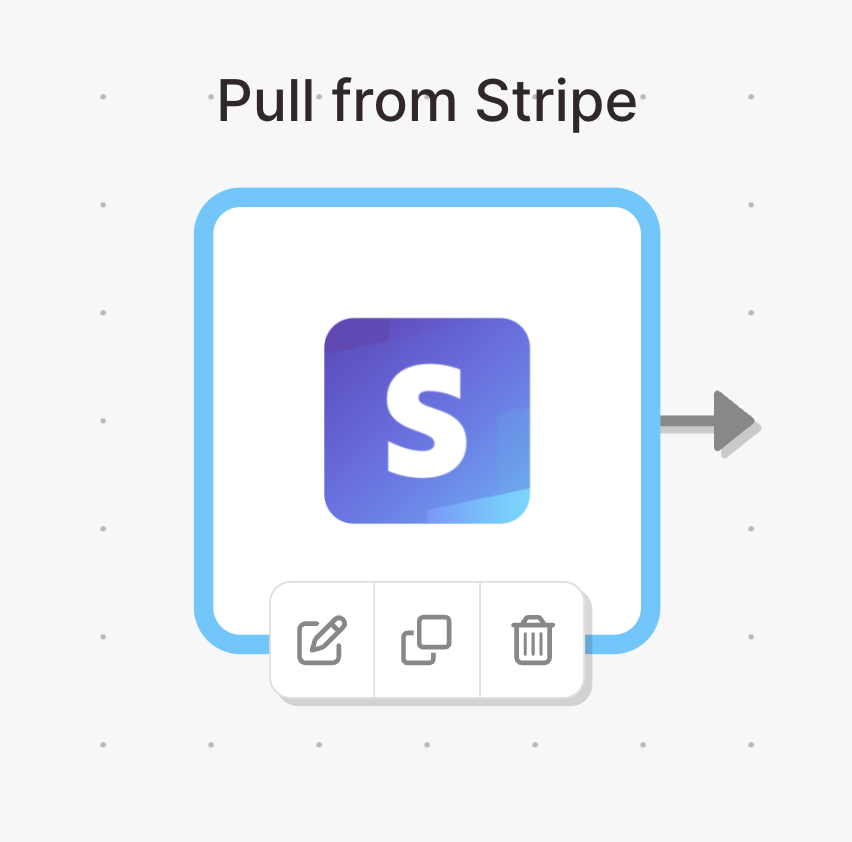
Copying and pasting steps within and between flows
We also have objects called snippets, which allow you to copy and paste multiple steps within a flow and between flows.
To create a snippet, first select the steps that you want to copy. If you copy steps connected together by arrows, their connections will be maintained when pasted. To select, you can hold the shift key and click on steps one by one. Or, you can hold shift, click on an empty portion of your canvas, and then drag a box to select a large group of steps. If you select unwanted steps, hold shift and click on a step to deselect it.
Now, copy the steps using your keyboard. Use ⌘/Ctrl + C to copy. You can also use your browser menu to copy. A yellow banner will appear: "Copied to clipboard. Note that copied steps may contain sensitive data."

Once you see that dropdown message, you can paste into a text document, where you would see something like this:
parabola:cb:af4f35234fc747a5b0bbda8bf14fefcf
That is what we call a snippet. Snippets do not expire so you can use one as many times as you need it. You can also share them with others to use, even users on different Parabola teams. To paste a snippet, copy that whole string and then use your keyboard or browser to past (⌘/Ctrl + V).
Snippets will contain everything they copied. If you copy a CSV or Excel file step, then that file will be in the snippet. If you copy an integration like Google Sheets or Shopify, it will not include any authorization details - so users will need to authorize with their own account. Be careful sharing snippets that contain API steps. API steps will bring along their settings, which may include API keys.
Navigating around the canvas
Flows are built on the canvas. It's where you add and arrange your steps and arrows. We've build the canvas to be far larger than your computer screen, so we've built helpful features to move around and navigate around your canvas.
Mini-map
The button to toggle the mini-map lives in the zoom toolbar in the bottom right corner of a Flow. Use this map to get a bird's-eye view of your entire Flow and click into the map to quickly jump to any section of the Flow without needing to zoom in and out manually.
Panning
For some very large flows, you'll need to pan around the canvas and get to all the steps. You can click and hold on to the canvas and then move your mouse to move the canvas. The other way to pan is to scroll. When using a trackpad, place two fingers on the trackpad and move them around. The canvas moves as you move your fingers. When using a mouse, use the scroll wheel. Spinning a scroll wheel will pan the canvas up and down. Holding the shift key and spinning the wheel will scroll horizontally left and right.
Zooming
You can zoom in and out of the canvas to adjust your view. Click on the slider in the bottom right and drag the dot left and right to decrease or increase the zoom level. When using a trackpad, zoom in and out by pinching in and out. When using a mouse with a scroll wheel, hold the command or the Apple key and then scroll the wheel to zoom in and out. That's zooming. It's good to note that the zoom uses the middle of the canvas as its point of reference so combining panning and zooming is a great way to effectively move around the canvas.
Adding cards
Cards are useful for grouping steps together and providing organization to your flow. They feature a rich-text editor to help document what a specific specific group of steps does. To add a card to your canvas drag a "New Card" from the sidebar into your flow. Drag additional steps over the card's drop targets to snap them into position. You can connect cards to steps that exist in other cards or on the canvas. They are especially useful when you have multiple collaborators on a flow so your teammates can quickly understand how you built the flow, what it does, and what they need to watch out for.
Undo / redo
You can undo (Ctrl + Z or ⌘ + Z) and redo (Ctrl + Y / Shift + Ctrl + Z or ⌘ + Y / Shift + ⌘ + Z) the last ~100 changes to your flow during your session. As you undo and redo, steps will automatically calculate to restore their old settings and results. (You'll notice that undoing or redoing will automatically move you to the corresponding place on your canvas.) Note that your session's undo/redo history is not saved when you leave the page.
Using keyboard shortcuts
Check out the full list in the keyboard shortcuts doc
Editing and updating your flow version(s)
For information on editing and updating your flow, head to the next article, Updating and running your flow.